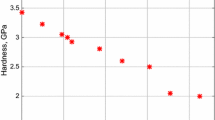Abstract
A dynamic computer model was developed to simulate wear behavior of materials on micro-scales. In this model, a material system is discretized and mapped onto a lattice or grid. Each lattice site represents a small volume of the material. During a wear process, a lattice site may move under the influence of external force and the interaction between the site and its adjacent sites. The site–site interaction is a function of mechanical properties of the material such as the elastic modulus, yield strength, work hardening and the fracture strain. Newton's law of motion is used to determine the movement of lattice sites during a wear process. The strain between a pair of sites is recoverable if it is within the elastic deformation range; otherwise plastic deformation takes place. A bond between two adjacent sites is broken when its strain exceeds a critical value. A site or a cluster of sites is worn away if all bonds connecting the site or the cluster to its nearest neighbors are broken. The model well describes the strain distribution in a contact region, in consistence with a finite element analysis. This model was applied to several metallic materials abraded under the ASTM G65 abrasion condition, and the results were compared to experimental observations. Good agreement between the modeling and the experiment was found.
Similar content being viewed by others
References
Ling, F.F. and Pan, C.H.T. (Eds.), Approaches to Modeling of Friction and Wear, Springer-Verlag, New York, NY, 1988.
Ludema, K.C. and Bayer, R.G. (Eds.), Tribological Modeling for Mechanical Designers, ASTM STP 1105, American Society for Testing and Materials, Philadelphia, PA, 1991.
Hsu, S.M., Shen, M.C. and Ruff, A.W., Tribology Int., 3 (1997) 377.
Challen, J.M. and Oxley, P.L.B., Wear, 53 (1979) 229.
Green, A.P., Proc. R. Soc. London, Ser. A, 228 (1955) 191.
Avitzur, B., Huang, C.K. and Zhu, Y.D.,Wear, 95 (1984) 59.
Edwards, C.M. and Halling J., J. Mech. Eng. Sci., 10 (1968) 101.
Komvopoulos, K. and Choi, D.H., J. Tribology, 114 (1992) 823.
Põdra, P. and Andersson, S.,Wear, 224 (1999) 13.
Hai, S., Pohl, H., Schomburq, U., Upper, G. and Heine, S., Wear, 224 (1999) 175.
Xuefeng, T. and Bharat, B., J. Tribology, 118 (1996) 33.
Hancock, P., Nicholls, J.R. and Stephenson, D.J., Surf. Coat. Technol., 32 (1987) 285.
Nicholls, J.R. and Stephenson, D.J., Wear, 186-187 (1995) 64.
Polycarpou, A.A. and Soom, A., Wear, 181-183 (1995) 32.
Jiaren, J., Stott, F.H. and Stack, M.M., Wear, 181-183 (1995) 20.
Wong, K.K. and Clark, H.M., Wear, 160 (1993) 95.
Turenne, S. and Fiset, M., Wear, 162-164 (1993) 679.
Haiyan, L. and Hsu, S.M., Wear, 195 (1996) 169.
Robbins, M.O. and Krim, J., MRS Bull., 23 (1998) 23.
Harrison, J.A., Stuarat, S.J. and Brenner, D.W., Atomic-Scale Simulation of Tribological and Related Phenomena, Handbook of Micro/Nanotribology, 1998.
Zhong, W. and Tomanek, D., Phys. Rev. Lett., 64 (1990) 30.
Elalem, K. and Li, D.Y., Proceedings of the International Conference on Powder Metallurgy & Particulate Materials (PM2TEC'99), Vancouver, Canada, 1999, in press.
Stevenson, A.N.J. and Hutchings, I.M., Wear, 195 (1996) 232.
Ruff, A.W., ASM International, Materials Park, OH, 1997, p. 22.
Callister, W.D., Materials Science and Engineering, An Introduction, John Wiley & Sons, New York, NY, 1997, p. 401.
Author information
Authors and Affiliations
Rights and permissions
About this article
Cite this article
Elalem, K., Li, D. Dynamical simulation of an abrasive wear process. Journal of Computer-Aided Materials Design 6, 185–193 (1999). https://doi.org/10.1023/A:1008701903799
Issue Date:
DOI: https://doi.org/10.1023/A:1008701903799




